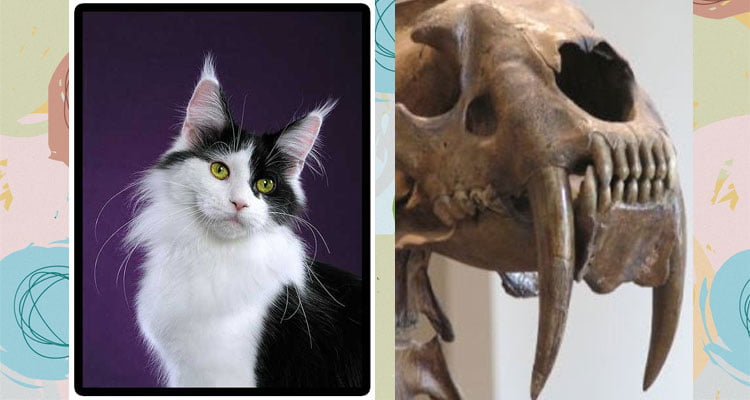Cat History – The height of modern, sophisticated cat breeding below – Miss Kate (photo copyright Helmi Flick) a Maine Coon cat champion next to the skull of a Saber Tooth tiger, extinct 10,000 years ago.

- Domestic cat history – from before cat to domestic cat (new page)
- Cat history pictures – 40 odd pictures of cats in an historical context (new page).
- ***See an alternative timeline of the cat – this is a good one***
Please note that this long page has been split up into several sections and at the base of each section there is a link to the next section. This has been done for technical reasons.
Introduction
The history of the cat should start with, and really should be about, the history of the wild cat. Wild cat history occupies 99.98% of all of the history of the cat. This is on the basis that wild cats first walked on this planet about a maximum of 5 million years ago and the wild cat became domesticated in Cyprus about 9,500 years ago (about the time the Saber Tooth Tiger became extinct). The remains of domestic cats next to their deceased owners in Cyprus have also been dated as 6,000 years old and it is said that they must have been imported into Cyprus because wildcats do not naturally occur on Cyprus4. Interestingly, today, in early 2010, a new cat breed is being created from Cyprus feral cats native to the island (see Birth of A New Cat Breed).
The dog, incidentally, was tamed and domesticated well before the cat because of its utility (believed 12,000 years ago10). The cat was probably amongst the last of the species to be tamed2.

Of course the exact date and place of the domestication of the wildcat is not certain. There is, though, little doubt that the area of the Mediterranean Sea was the center (the Mediterranean Basin – The Ascent of Cat Breeds). This includes Cyprus and Egypt. Although a recent Scientific American article states that dometication started in the Fertile Crescent11. This is an area just to the east and south east of the Mediterranean Sea – see map12>>
Update April 2011: Recent research may indicate that domestication of the cat also took place in Peru some 3.500 year ago.
I wrote a potted history of the big cats, which kicks off the history of the cat: History Of The Big Cats.
Most visitors will want to know about the history of the domestic cat so although it only occupies .02% of all history of the cat it is the focus of attention here. One reason for this is that the pressing topic for the wild cats is currently (at Jan 2010) not its history but its future. The big question is how we can live in harmony with the wildcat (not captive wildcats), if that is what we want.
Another reason why discussing the domestic cat is more pertinent is that there are about 500 million domestic cats in the world and only a tiny fraction of that number are wildcats, which means that about 99.98% of all cats on the planet are domesticated. This is a nice symmetry with the history. The rapid decline in the wild cat population is mirrored by the rapid increase in the domestic cat population over the last 150 years or so. This reflects humankind’s attitude towards nature – control. Today, the cat is the most favoured pet in the west, with about 8 million in the UK and about ten times that in the USA. Because of its utilitarian skills, dogs are probably favoured in eastern countries (Dogs versus Cats).
Ultimately, cat history for people is mainly about the domestic cat and I focus on that initially. This page is always work in progress to a certain extent, however.


Comments are closed.